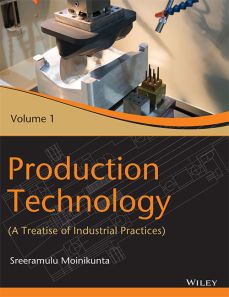Production Technology, Vol 1: A Treatise of Industrial Practices
ISBN: 9788126571253
396 pages
eBook also available for institutional users
For more information write to us at: acadmktg@wiley.com

Description
Production Technology (Vol. I) is a ready reckoner data handbook for the practicing engineers and technicians in the manufacturing engineering industry. It aims to re-orient the students or the just-passed-out graduates and develop in them the skills required for the industry as a whole, in particular, for the manufacturing engineering industry. It gives reference or guidance data in the form of figures, tables and photos. This book intends to be readily referred as a reference guide for all relevant subjects with appropriate application knowledge, which is specified in design practices. The book is designed to provide the students an industry-compatible education. Inclusive of all sorts of practical approaches, this book would be an asset to both students and industry as it bridges the gap between educational institutions and the industry and gives an insight to suitable subjects in abridged manner.
Foreword
Preface
About the Author
Acknowledgments
Chapter 1: Casting Process
1.1 Introduction
1.2 History
1.3 Definition of Casting Terms
1.4 Classification of Casting Process
1.5 Steps Involved in Casting Process
1.6 Molding Equipment or Machinery
1.7 Mold Materials
1.8 Sand Testing
Chapter 2: Gating Systems
2.1 Introduction
2.2 Pouring Basin
2.3 Sprue
2.4 Pouring Time
2.5 Runner and Gates
2.6 Design of Riser
2.7 Methods of Riser Calculations
2.8 Filling System Design
2.9 Yield
Chapter 3: Special Casting Processes
3.1 Introduction
3.2 Expendable Castings
3.3 Permanent Mold Castings
Chapter 4: Metal Melting Furnaces
4.1 Introduction
4.2 Salient Features of Furnace Design or Components of Furnace
4.3 Application of Furnaces in High Temperature Industries
4.4 Types of Furnaces
4.5 Crucible Melting
4.6 Cupola Furnace
4.7 Pit Furnace
4.8 Reverberatory Furnace
4.9 Induction Furnace
4.10 Electrical Arc Furnace
4.11 Electrical Resistance Furnace
4.12 Tilting Rotary Furnace (Bessemer Converter)
Chapter 5: Melting, Pouring, and Casting Quality
5.1 Heating and Pouring
5.2 Pouring of Molten Metal
5.3 Solidification of Metals
5.4 Causes and Remedies of Casting Defects
5.5 Quality Considerations in Casting Design
5.6 Parameters of Cost-Effective Design
5.7 Quality Tests of Castings
5.8 Criteria for Selection of Casting Process
5.9 Cleaning or Fettling of Castings
Chapter 6: Lean Six Sigma
6.1 Introduction
6.2 Lean Manufacturing
6.3 How Does Lean Work?
6.4 Lean Principles
6.5 Time-Tested Tools for Lean Production
6.6 Lean Progression Model
6.7 Six Sigma
6.8 Six Sigma Methodologies Applied in Product Lifecycle
6.9 Quality Management Tools
6.10 Six Sigma Implementation Roles
6.11 What Is Lean Six Sigma?
6.12 Design for Six Sigma (DFSS)
6.13 Training for Lean Six Sigma
Chapter 7: Theory of Metal Forming
7.1 Introduction
7.2 Classification of Forming Processes
7.3 Classification by Stresses
7.4 Theory of Metal Forming
7.5 Cold Metal Forming
7.6 Main Laws of Plastic Deformation
7.7 Warm Working
7.8 Hot Metal Forming
7.9 Recovery, Recrystallization, and Grain Growth
Chapter 8: Bulk Metal-Forming Processes
8.1 Introduction
8.2 Description of Metal-Forming Processes
8.3 Characteristics of Forging
8.4 Indenting or Coining
8.5 Metal Spinning
Chapter 9: Sheet Metal-Forming Processes
9.1 Introduction
9.2 Conventional Sheet Forming Processes
9.3 Shearing Operation
9.4 Special or Advanced Sheet Metal-Forming Processes
9.5 High Velocity Forming (HVF) or High Energy Rate Forming
9.6 Characteristics of Sheet Metal-Forming Processes
9.7 Presses
9.8 Press Tools
9.9 Construction of Press Tool
9.10 Sheet Metal Test Methods
9.11 Metal-Forming Defects
Chapter 10: Welding Processes
10.1 Introduction
10.2 Arc Welding
10.3 Welding Symbols
10.4 Resistance Welding
10.5 Butt Welding
10.6 Electrodes
10.7 Fluxes
10.8 Weld Defects and Weld Testing
10.9 AC and DC Arc Welding
Chapter 11: Advanced Welding Technologies
11.1 Introduction
11.2 Categories of Welding Technologies
11.3 Advanced Welding Technologies
11.4 Pressure Welding
Chapter 12: Gas Welding and Cutting
12.1 Introduction
12.2 Oxy-Fuel Equipment
12.3 Fuels
12.4 Types of Flames
12.5 Gas Welding
12.6 Gas Cutting
12.7 Safety Precautions
12.8 Brazing and Soldering
12.9 Gas Pressure Welding
12.10 Methods of Gas Butt Welding
Chapter 13: Powder Metallurgy
13.1 Introduction
13.2 Criterion to Select Powder Metallurgy Process
13.3 Powder Metallurgy Process
13.4 Techniques of PM Processes
13.5 Powder Production Technologies
13.6 Powder Compaction
13.7 Sintering
13.8 Secondary or Finishing Operations
13.9 Advantages and Limitations
13.10 Applications of Powder Metallurgy
Chapter 14: 3D Printing
14.1 Introduction
14.2 Types of Additive Manufacturing Processes
14.3 Direct Metal Laser Sintering (DMLS)
14.4 Applications of 3D Printing
14.5 Future
14.6 Utilization
14.7 Materials Used in 3D Printing
Chapter 15: Plastic Processes
15.1 Introduction
15.2 Classification of Plastics
15.3 Plastic Chemical Compounds
15.4 Polymers
15.5 Ingredients of Molding Compound
15.6 Processing and Fabrication of Plastics
15.7 Processing of Plastics
15.8 Lamination and Reinforcement
15.9 Secondary Processing or Finishing of Plastics
Summary
Review Questions
Objective-Type Questions
Short Answer Questions
Long Answer Questions
Gate Model Questions
Answers
References
Index

